
John Stobart Collection
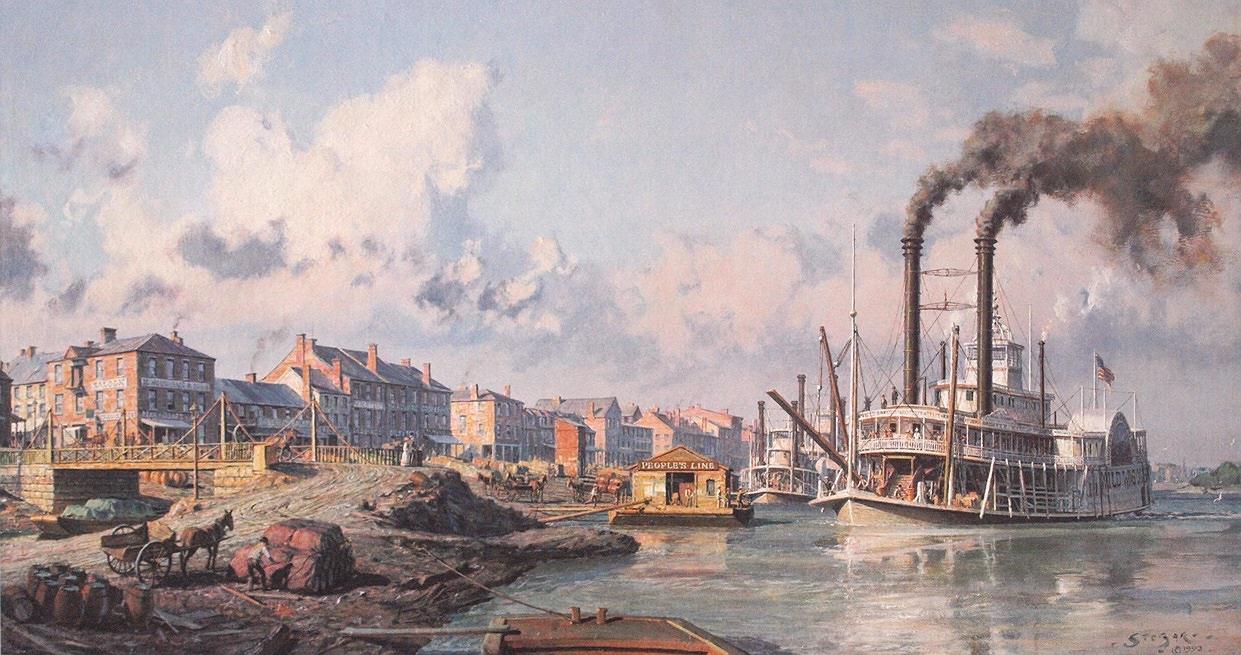
Recently acquired print from a painting by John Stobart
The architecture of the commercial buildings on the waterfront are typical of river cities and rivertowns like Hannibal, Missouri as it appeared when Sam Clemens was a boy there before the Civil War.
LOUISVILLE by John Stobart
The People's Line Packet "Wild Wagoner" arriving at the Levee in 1868
18 x 29 inches Issued: 1993
Louisville, Kentucky on the Ohio River in 1868 at 2nd Street and the mouth of Beargrass Creek.
The arriving Cincinnati and Louisville packet WILD WAGONER edges towards the Peoples Line wharf boat in mid-morning as people along Water Street go about their daily business.
New acquisition: framed John Stobart print.
ST. LOUIS. The "Gateway to the West" in 1878 {Issued: 1978 }
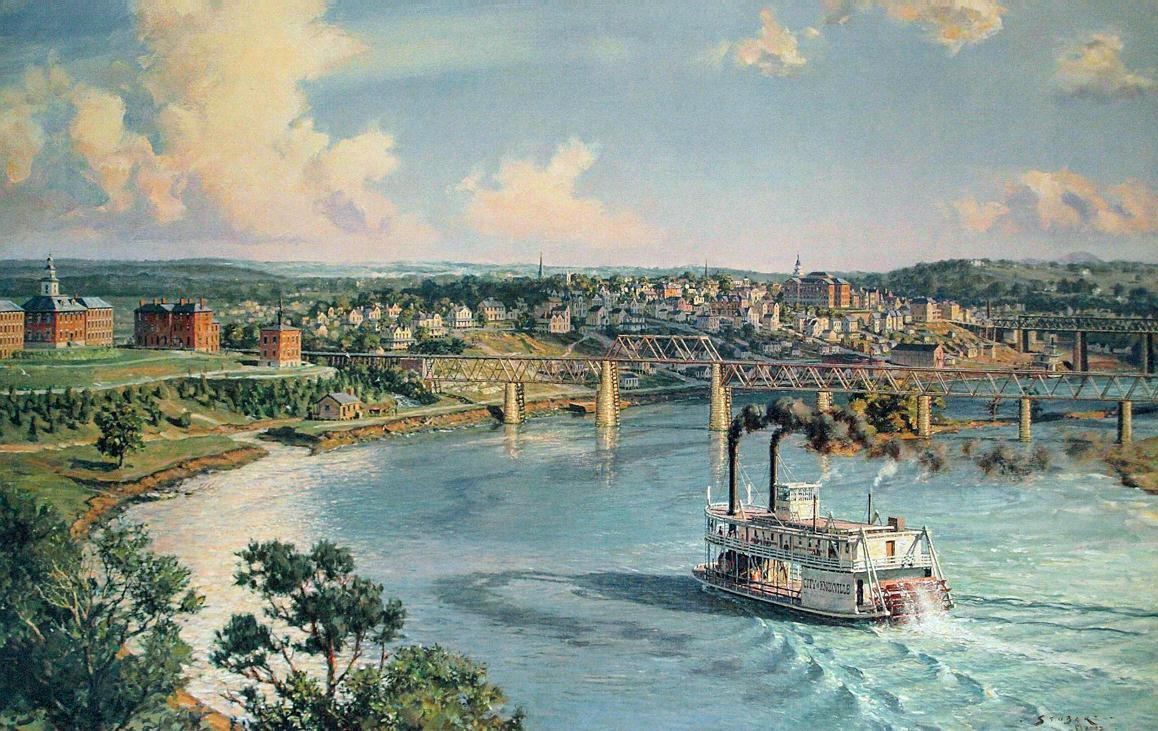
John Stobart's 2002 painting of KNOXVILLE, TENNESSEE entitled "The 'City of Knoxville' arriving from Chattanooga in 1891."
The image area seen here is 18 x 28 1/2 inches.
Fred Way's Packet Directory lists 3 sternwheel steamboats who were named City of Knoxville, but no steamboat named City of Knoxville operating in 1891.
The first C of K's dates were 1854 to 1858; the second boat's dates were from 1875 to 1883; and the third boat's dates were from 1896 to 1901
Perhaps there was a 4th boat by that name that did operate in 1891 that is not listed in Way's Directory.
The J. Russell Jinishian Gallery, Inc. of Fairfield, Connecticut has the original painting listed at $250,000 jrusselljinishiangallery.com
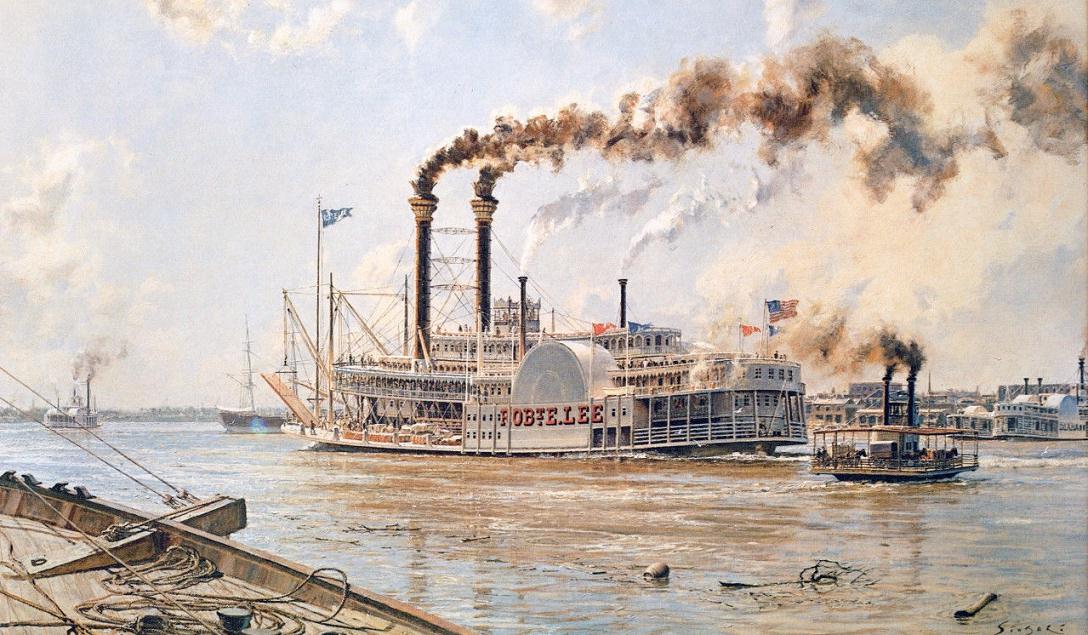
John Stobart painted this in 1978. This is a detail and an appealing composition, that is the deck of a sailing ship in lower left corner . . . Original limited edition prints of this are expensive but can be found on eBay if you've got a windfall and want to invest in a deluxe Stobart.
NEW ORLEANS, ROBERT E. LEE, LEAVING CRESCENT CITY 1880
This ROB'T E. LEE was the second boat bearing that name; she was nicknamed "Hoppin' Bob." Launched April 1876, at Jeffersonville, Indiana where she was built at the Howard boat yard. Lost in a fire at Yucatan Plantation, Louisiana in September of 1882. The first ROB'T E. LEE beat the NATCHEZ in a race from New Orleans to St. Louis in 1870.
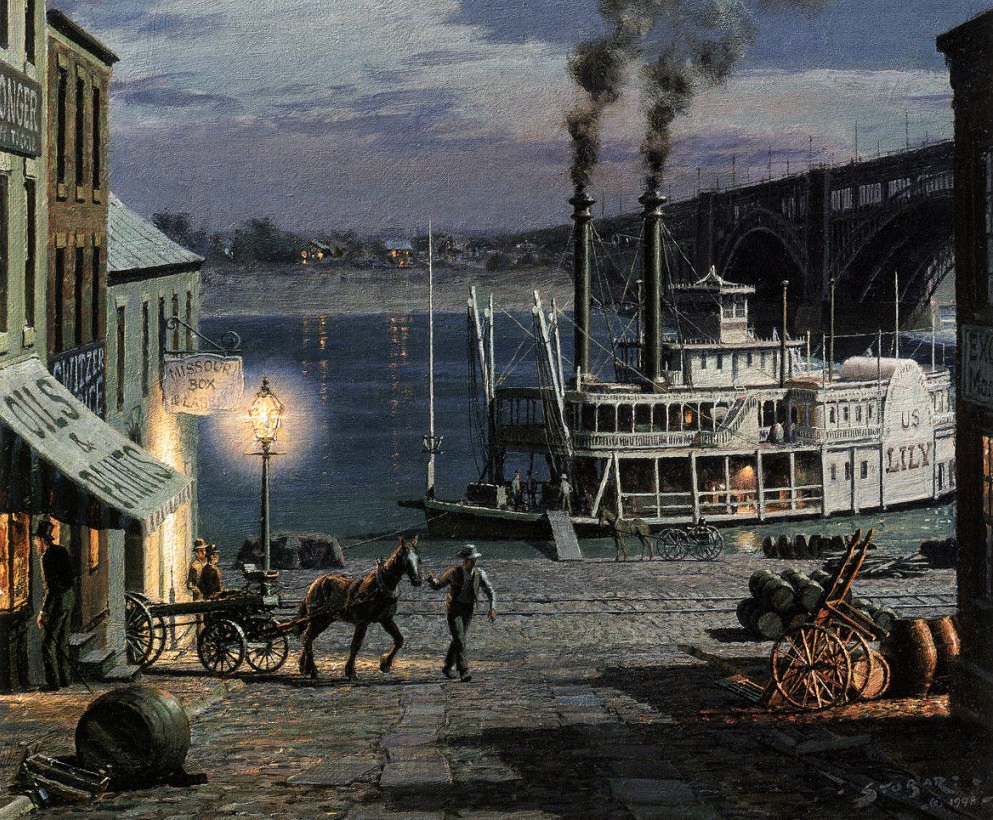
Stobart U.S. LILY detail
The Scrimshaw Gallery in Sausalito, California offer an extensive selection of John Stobart prints for sale: scrimshawgallery.com
Detail from beautiful night time imagining of the U.S. LILY at Lacede's Landing on the Mississippi at St. Louis.
St. Louis: Laclede's Landing c. 1885 by John Stobart
St. Louis's riverfront near the foot of Lucas Street. Laclede's Landing was all that remained of the original French village, built around the trading post founded in 1763 by Pierre Laclede Liguests and Auguste Chouteau.
U.S lighthouse tender LILY at the river's edge in 1885, behind the LILY is a portion of the Eads Bridge, built in 1874 by engineer James B. Eads who designed the three spans to stand on stone pillars that are submerged in bed rock far below the bottom of the river. The Eads Bridge still withstands the strongest currents of the Mississippi during high water.
Stobart BELLE AMOUR moonlight
The Scrimshaw Gallery in Sausalito, California offer an extensive selection of John Stobart prints for sale: scrimshawgallery.com
Night Call at Bayou Sara by John Stobart
BELLE AMOUR being loaded with cotton bales by the diffused light of a full moon hanging high above in a misty night sky , at Bayou Sara, Louisiana. One of Stobart's most atmospheric paintings.
The little town of Bayou Sara was wiped out by the devastating Mississippi River flood of 1927, today there is a ferry landing where the village stood.
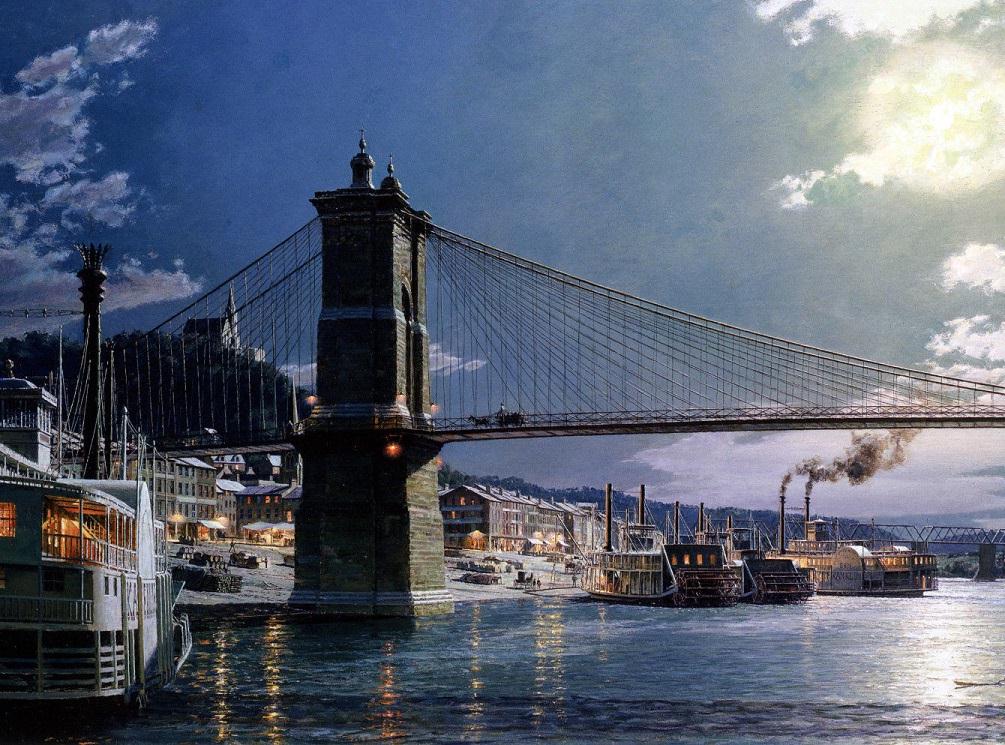
"Cincinnati, Ohio on the Ohio River : The Public Landing by Moonlight in 1884"
The Scrimshaw Gallery in Sausalito, California offer an extensive selection of John Stobart prints for sale: scrimshawgallery.com
"Cincinnati, Ohio on the Ohio River : The Public Landing by Moonlight in 1884" painted by John Stobart
The packet KATE ADAMS is in the foreground on the far left.
Construction on the Roebling Suspension Bridge was begun in 1856 but suspended during of the Civil War as a precaution to prevent a possible invasion of the city by the Confederate army if they crossed the bridge from the Kentucky side of the Ohio River had it been completed.
When the bridge was finished in 1867 it became celebrated as the longest in the world. It was designed to carry the relatively lightweight horse drawn traffic of the 19th century so the bridge's span was narrower at the outset than it is today. With the advent of heavy motorized vehicles the bridge was reinforced with heavy girders.
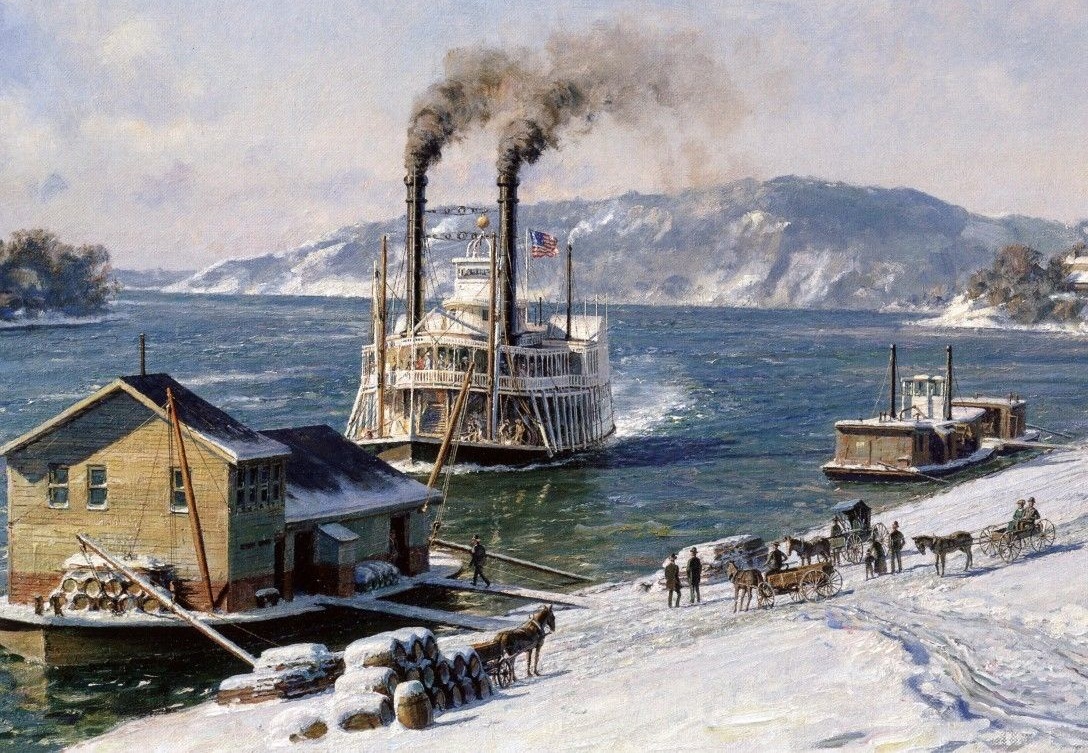
Steamboat COURIER Arriving in 1875
The Scrimshaw Gallery in Sausalito, California offer an extensive selection of John Stobart prints for sale: scrimshawgallery.com
Detail of Marietta: The Mail Line Packet "Courier" Arriving at the Wharfboat on the Ohio in 1875, John Stobart
Marietta, Ohio's levee from Ohio Street as the U.S. Mail Packet COURIER arrives following an early snow fall.
In the years following the Revolution America's Inland Waterwars formed the essential transportation routes and because of its location, at the confluence of the Muskingum and Ohio rivers, Marietta became the logical center of transportation for the interior of the Ohio Territory.
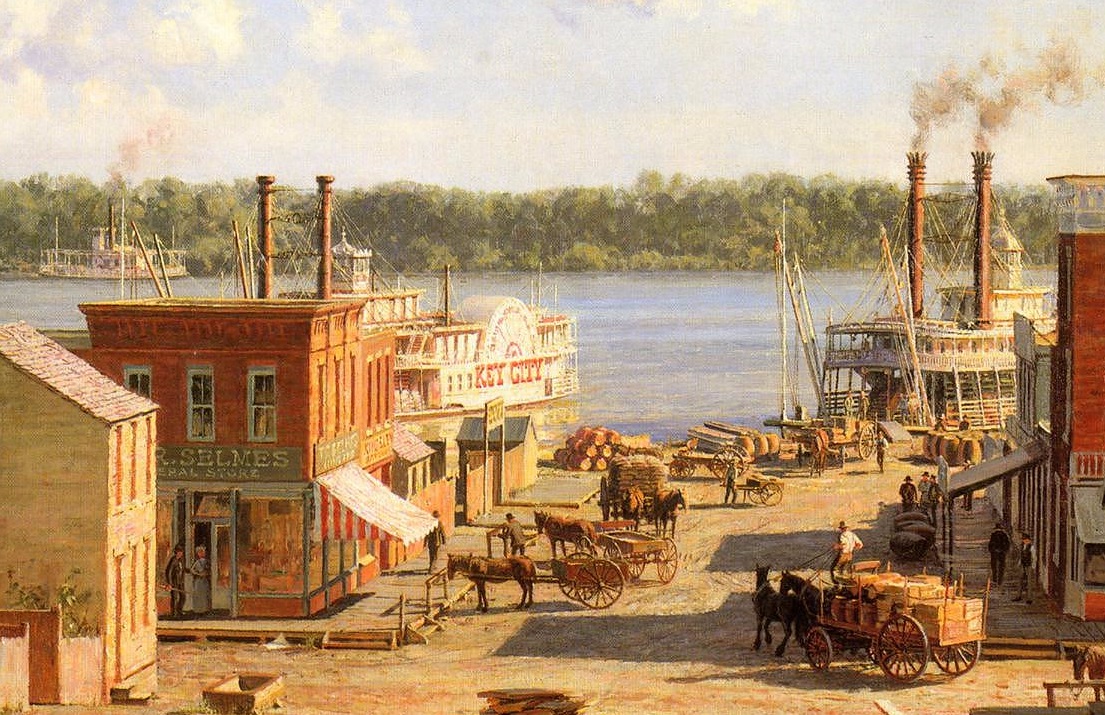
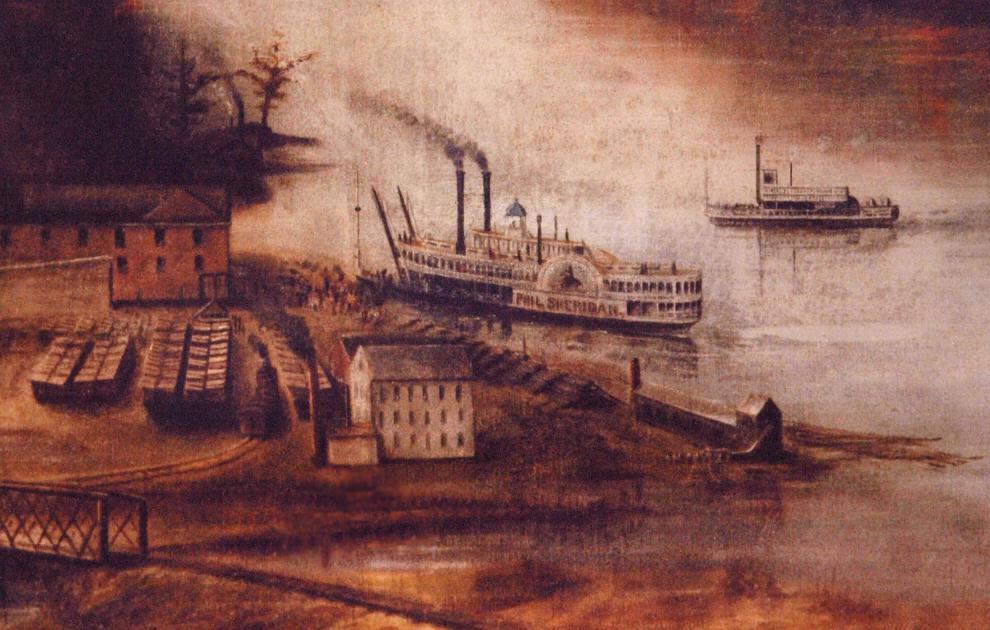
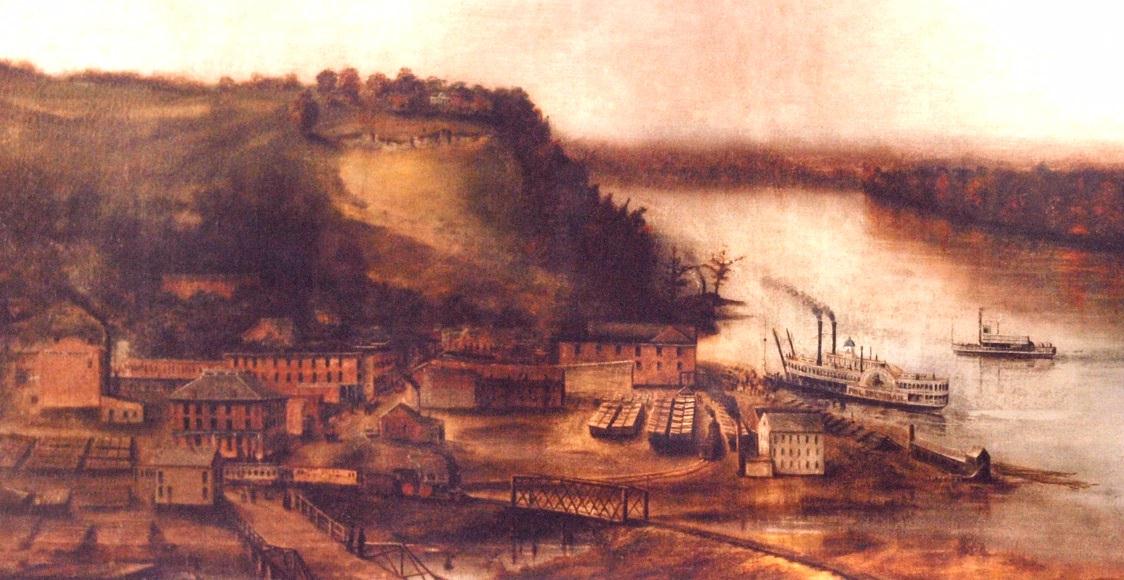
The Scrimshaw Gallery in Sausalito, California offer an extensive selection of John Stobart prints for sale: scrimshawgallery.com
Detail from John Stobart's painting of HANNIBAL, MO with the steamboat KEY CITY (1857-1869) In the distance far left cross the river a steam ferry shuttled passengers and wagons back and forth from Hannibal and Illinois.
The distinctive octagonal pilot house aboard the steamboat on the right suggests that Stobart probably intended it to be the PHIL SHERIDAN (1865-1876).
In 1869 artist and photographer George Crosby (1833-1877) painted a panoramic view of Hannibal from the vantage point of the bluffs south of town looking north towards Holliday's Hill (Sam Clemens renamed Holliday's Hill "Cardiff Hill" in TOM SAWYER) and in the attached detail the SHERIDAN can be seen at the landing beyond the pork packing complex a short distance up river from the mouth of Bear Creek. A ferry can be seen to the right of the SHERIDAN.
A Waterways Journal article on the SHERIDAN by Keith Norrington mentions that the steamer operated on the Upper Mississippi River for 10 years:
KEY CITY
Sidewheel Packet
Way's Packet Directory Number 3278
Built in Cincinnati, Ohio, 1857
First home port was Dubuque, Iowa
inspected at Galena, 5th district report, 1867
The KEY CITY was a twin to the ITASCA so their parts were interchangeable.
Owned by the Galena and Minnesota Packet Company (a.k.a. the Minnesota Packet Company, 1857
Northwestern Union Packet Company, 1864
She ran Galena-Dunleith-St. Paul and according to one source, was the first boat through Lake Pepin.
In a collision with the sternwheel packet BEN COURSIN at the mouth of the Black River, near La Crosse, Wisconsin, August 24, 1857, the COURSIN sank with the loss of seven lives.
The KEY CITY arrived at Madison, Indiana for dismantling on December 6, 1869.
The Phil Sheridan Had An Octagonal Pilothouse
waterwaysjournal.net
OCTOBER 22, 2018
BY KEITH NORRINGTON
Noted for being one of few riverboats to have an octagonal pilothouse, the PHIL SHERIDAN was built for a cost of $80,000 in 1865 at Cincinnati, Ohio. Constructed on a wooden hull that measured 227 by 36-1/2 feet, the boat had four boilers that supplied steam to high-pressure engines (built by C.T. Dumont) having 22-inch cylinders with a 7-foot stroke. The paddlewheels were 28 feet in diameter with bucket planks 12 feet long. The boat drew 32 inches of water when light and had a capacity for 700 tons of freight.
The boat was designed for the Wheeling-Cincinnati trade under the command of Capt. Charles Muhleman, with Capt. Amos Davis and Capt. Phil Anshutz, pilots; Chris Young and Charles Knox presided in the clerk's office and James Hall was the engineer.
In this week's Old Boat Column image, the sidewheeler has just arrived (January 1866) at Wheeling on its maiden trip. The new steamboat's arrival was particularly noteworthy, inasmuch as it was named for a famous Civil War general. The Sheridan proved to be a very fast boat, a quality which made a steamboat popular. The boat made its trial trip in the Cincinnati harbor on January 20, 1866.
On March 7 of that year, Capt. Muhleman sent a telegram to the wharfboat at Wheeling:
"SHERIDAN PASSED TELEGRAPH NO. 3 UNDER WAY FAIR AND SQUARE."
The Telegraph No. 3 was a fast boat, having set a record between Louisville and Cincinnati on April 13, 1853. The record stood until the CITY OF LOUISVILLE broke it on April 19, 1894.
The widespread reports of the Sheridan's excellent speed performance undoubtedly caused Capt. P.S. Davidson of the Upper Mississippi River to come aboard with an attractive offer for the boat. Capt. Muhleman agreed to sell the vessel upon its return to Cincinnati from one more round trip to Wheeling. It was on this trip that the Sheridan encountered a severe wind storm at Straight Creek, below Dover, Ky; the twin smokestacks were blown down, with other damage to the upper works. The boat immediately returned to Cincinnati for repairs costing $1,500. A week later, the vessel was delivered to the Davidson Line, and the steamer Potomac took the Sheridan's place in the Wheeling and Cincinnati trade.
For 10 years, the Phil Sheridan operated on the Upper Mississippi River, maintaining its reputation for speed. During that period, the riverboat made one trip to Pittsburgh, arriving in that city on March 25, 1870, in command of Capt. E.V. Holcombe. The Ohio River pilots were Capt. William Hall and Capt. John Shouse. The trip was booked in Pittsburgh, direct for St. Paul.
In 1876, while the Sheridan was hauled out on the La Crosse marine ways for repairs, the cradles gave way and the boat sank. The condition of the vessel was such that salvage was impossible.
The steamboat was dismantled and the machinery was placed aboard the Belle of Minnetonka. Later, the engines were shipped to Alaska and used aboard the Yukon River packet Susie.
Editor's note:
For questions or suggestions regarding the Old Boat Column, Keith Norrington may be contacted by e-mail at curatorkeith@yahoo.com, or by mail through the Howard Steamboat Museum at P.O. Box 606, Jeffersonville, Ind. 47131-0606.
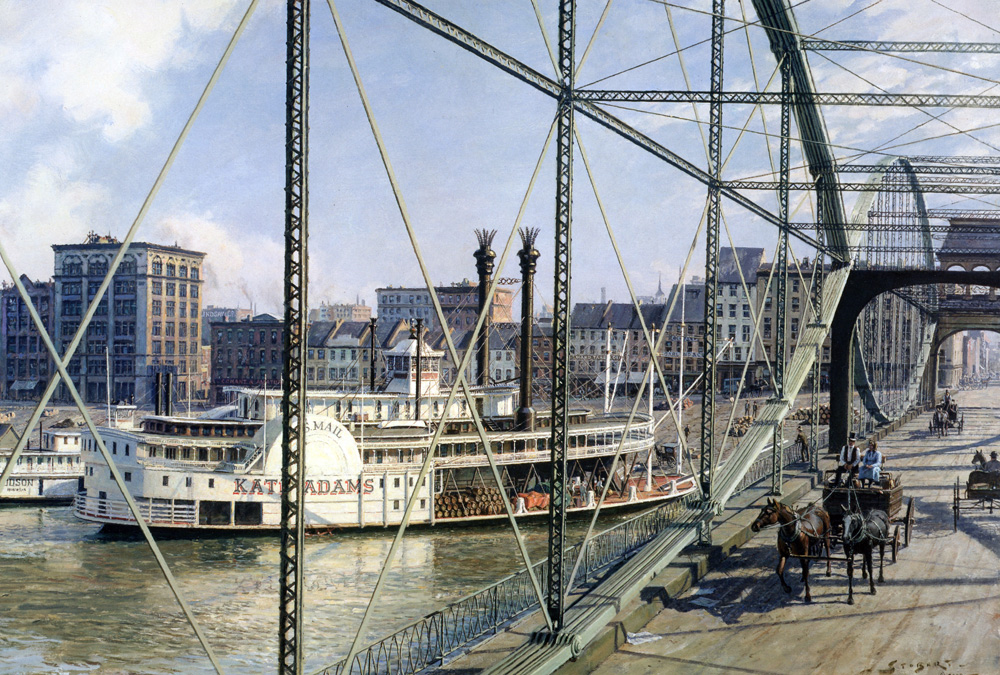
Stobart KATE ADAMS at Monongahela Wharf Seen from Smithfield Street Bridge, 1883
JOHN STOBART:
Pittsburgh: KATE ADAMS at Monongahela Wharf from Smithfield Street Bridge, 1883
The Monongahela Wharf where the Monongahela Hotel was located became the hub of commercial Pittsburgh. It was head of navigation for the taller stacked boats, and therefore terminus for the larger packets like the AMERICA and KATE ADAMS. The second of four boats named KATE ADAMS at the busy landing in front of the Monongahela Hotel seen from a viewpoint above the deck of the Smithfield Street Bridge in Pittsburgh, Pennsylvania. From this location in 1883 the KATE ADAMS is about to depart for Memphis, Tennessee to be delivered to her owners, the Memphis and Arkansas City Packet Co.
The KATE ADAMS, designed to serve as a cotton packet, was built twelve miles down the Ohio River at the Sewickley boat yard and afterwards her machinery was installed by James Rees & Sons Co. at Pittsburgh.
The wide lower deck of the Kate Adams was designed to carry over a thousand bales of cotton during the harvest season and on the second deck the passenger accommodations were luxurious with her interior finished in ash, walnut, cherry, bird's-eye maple and mahogany. The sternwheel boat at the left is the upper Ohio River packet HUDSON. Sternwheel boats were economical to operate and well suited to the upper Ohio River trade where frequent landings at small villages and farms were required.
A covered bridge was first built here across the Monongahela to connect the growing city with the south side, but was destroyed in the great fire of April 10, 1845. It was replaced in 1846 by a multiple span suspension bridge which was one of the first to be designed by John Roebling.
This narrow bridge was replaced in 1861 by a unique design known as a lenticular span, sometimes, though rarely, used in railroad bridges.
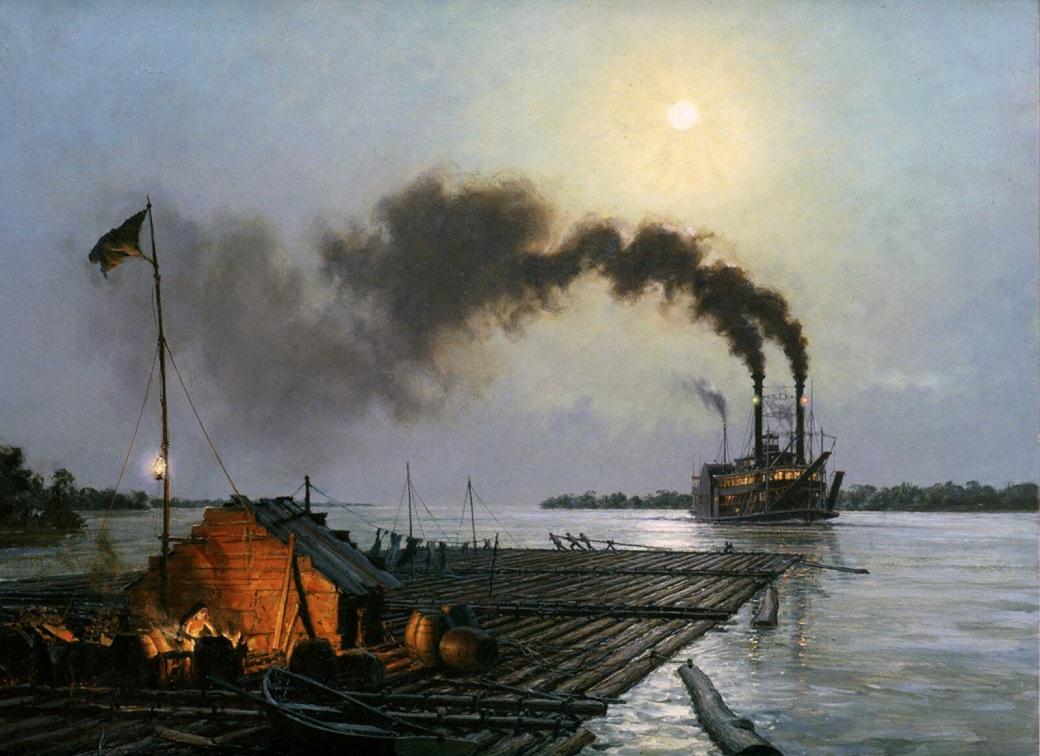
STOBART Rafting On The Missouri
Rafting On The Missouri
scrimshawgallery.com
Log rafts, which give rise to thoughts of escaping to a world of freedom and adventure, were assembled on the banks of rivers of the upper Mississippi basin. They were crudely fastened together in order to be floated down the river to the sawmills of New Orleans where they were sold. A boat was taken along so that raftsmen could feed themselves by begging, borrowing or stealing from the farms en-route.
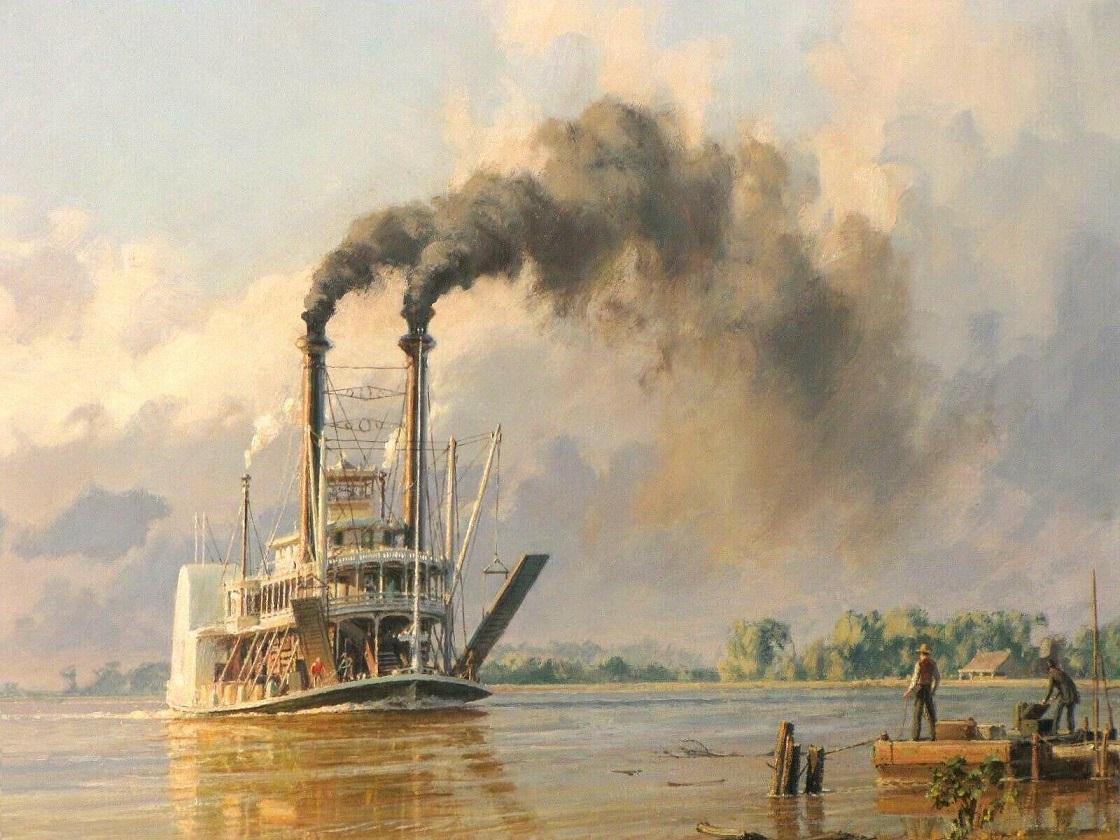
Stobart original steamboat painting
DETAIL from:
JOHN STOBART Original Oil Painting Canvas 24"x36" Signed Riverboat
"Landing on the Red River" 1977
$17,999.99
$150.00Shipping
for sale on eBay
eBay

With the exception of images credited to public institutions,
everything on this page is from a private collection.
Please contact Steamboats.com for permission for commercial use.*
All captions provided by Dave Thomson, Steamboats.com primary contributor and historian.
